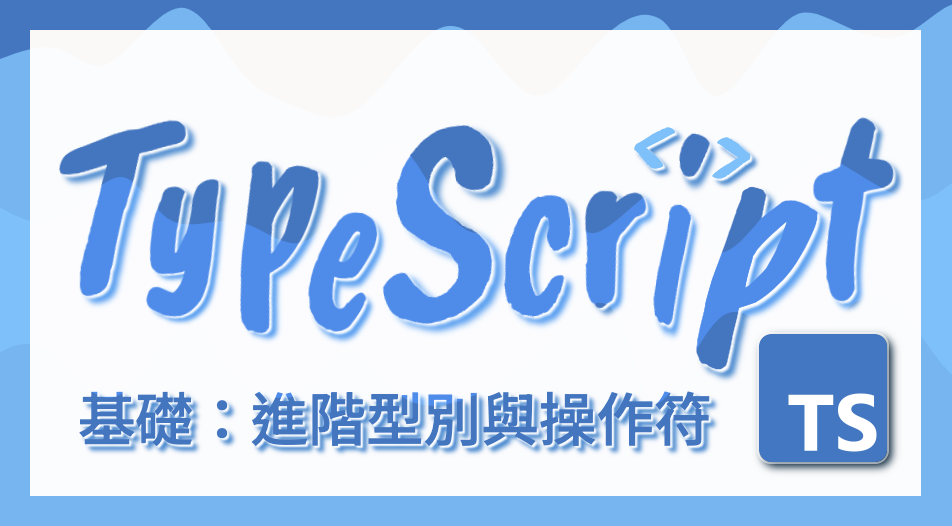
在前幾篇中,我們介紹了 TypeScript 的基本型別與物件型別。在本篇中,將深入探討進階的型別系統,包括聯合型別、交集型別、型別斷言等。
聯合型別 | ,允許一個值是多種型別之一。這讓我們可以靈活地接受不同的型別輸入,而不用強制規範為單一型別。
// 利用 | 將不同型別聯合在一起,允許 id 是數字或字串
let id: number | string;
id = 123;
id = 'abc123';
// id = false; // Error: 類型 'boolean' 不可指派給類型 'string | number'。
function printId(id: number | string) {
// 用判斷的方式來推斷型別
if (typeof id === 'string') {
// TypeScript 推斷 id 是 string 型別
console.log(id.toUpperCase());
} else {
// TypeScript 推斷 id 是 number 型別
console.log(id);
}
}
printId(123); // 123
printId('abc123'); // ABC123
交集型別 & ,允許將多種型別合併,從而要求值同時符合多個型別。這在需要融合不同物件的屬性時非常有用。
type Person = {
name: string;
}
interface Employee {
position: string;
}
// 利用 & 將不同物件融合,同時會有 Person 與 Employee 的屬性
type EmployeePerson = Person & Employee;
const employee: EmployeePerson = {
name: 'Johnson Mao',
position: 'Frontend',
};
console.log(employee.name); // Johnson Mao
console.log(employee.position); // Frontend
注意:
當兩個都是原始類型(例如:string & number)進行交集操作時,結果會是never類型,表示沒有任何值能同時是這兩個原始類型。這一點需要特別注意,因為它會導致變數無法賦值任何值。
型別斷言允許開發者手動告訴 TypeScript 某個值的具體型別。這在 TypeScript 無法正確推斷型別時特別有用,但需小心使用以避免出錯。
// TypeScript 會推斷 inputElement 的類型是 HTMLElement | null
// 我們知道它實際上是 HTMLInputElement,所以需要型別斷言
const inputElement1 = document.getElementById("username") as HTMLInputElement;
inputElement1.value = "New Username";
// 另一種寫法,使用尖括號型別斷言(僅在 .tsx 以外的檔案中可用)
const inputElement2 = <HTMLInputElement>document.getElementById("username");
inputElement2.value = "Another Username";
備註:HTMLInputElement 是 DOM 的類別
可選操作符 ? 用來表示一個屬性或參數是可選的,即這個屬性或參數可以存在,也可以不傳遞。這為處理物件屬性或函式參數提供了更大的靈活性。
// 物件的可選屬性
interface Person {
name: string;
age?: number; // 可選屬性,不一定要有這個屬性
}
const person2: Person = { name: "Mao", age: 18 };
const person1: Person = { name: "Lily" };
// 函式的可選參數,不一定要傳這個參數
function calculateDiscountedPrice(price: number, discount?: number): number {
let finalPrice = price;
if (discount) {
finalPrice -= price * (discount / 100);
}
return finalPrice;
}
允許你定義可以用索引存取的物件型別。這意味著你可以使用索引(通常是字串或數字)來存取物件的屬性,並且可以為這些屬性指定特定的型別。這對於需要動態存取或編寫動態屬性的物件非常有用。
interface StringIndexable {
[key: string]: number; // 索引簽名,字串索引對應數字型別
}
const scores: StringIndexable = {
math: 95,
english: 88,
science: 92
};
console.log(scores.math); // 95
此外 PropertyKey 是常規物件可以使用的索引型別,他同時聯集了
string | number | symbol
非空斷言操作符 ! 用來告訴 TypeScript 編譯器,某個值不會是 null 或 undefined,即使編譯器推斷它可能是。這個操作符允許我們在不進行明確檢查的情況下,繼續操作這個值。
// TypeScript 認為 element 可能是 `HTMLElement | null`
const element = document.getElementById("myElement");
// 非空斷言操作符告訴編譯器,element 不會是 `null`
element!.className = "active";
// 但更好的做法會是用判斷的方式推斷
if (element) element.className = "active";
